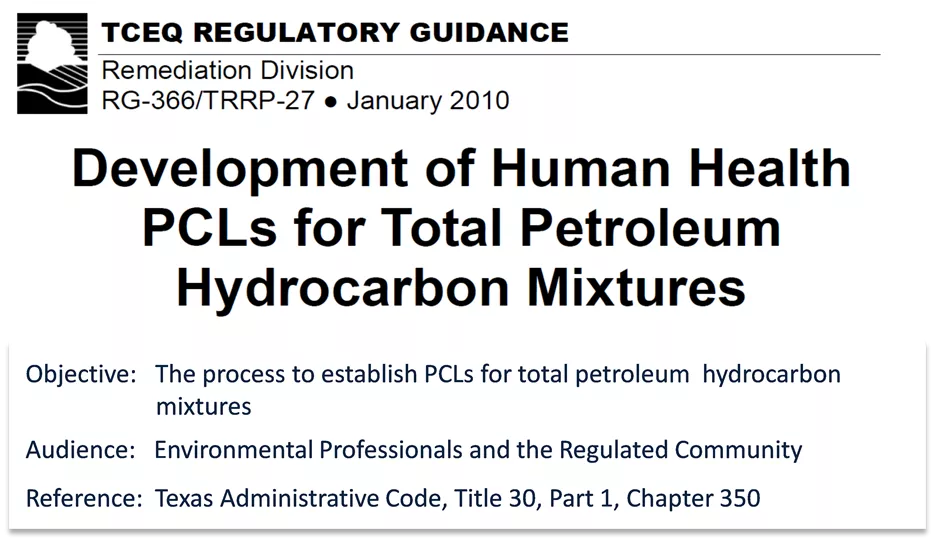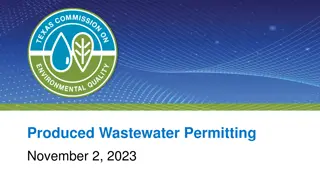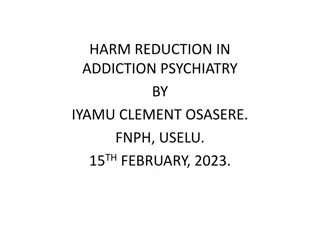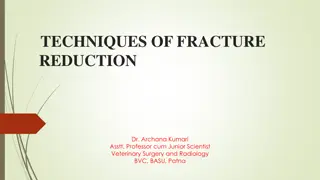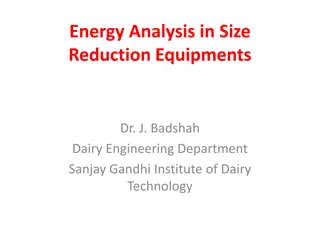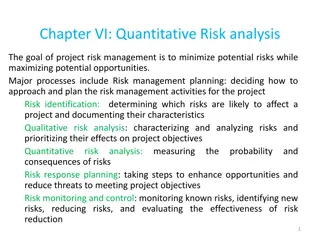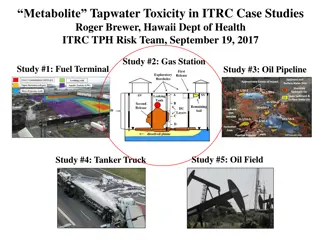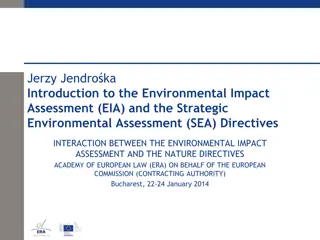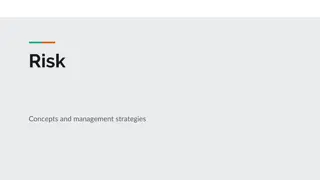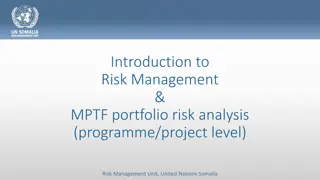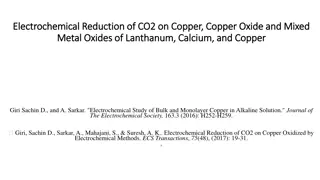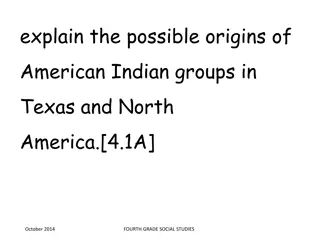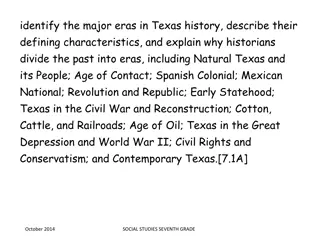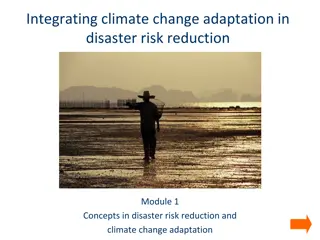Overview of Texas Risk Reduction Program (TRRP) for TPH Environmental Impact
The Texas Risk Reduction Program (TRRP) provides guidelines for managing Total Petroleum Hydrocarbons (TPH) in environmental assessments. Different regulations and programs govern TPH analysis depending on the source, with specific methods like TCEQ Method 1005 and 1006 used for TPH analysis and determining protective concentration levels (PCLs). TRRP offers guidance on a risk-based surrogate approach, TPH analytical methods, and PCL development processes. Environmental professionals and the regulated community can refer to TRRP for establishing PCLs for petroleum hydrocarbon mixtures.
Download Presentation

Please find below an Image/Link to download the presentation.
The content on the website is provided AS IS for your information and personal use only. It may not be sold, licensed, or shared on other websites without obtaining consent from the author. Download presentation by click this link. If you encounter any issues during the download, it is possible that the publisher has removed the file from their server.
E N D
Presentation Transcript
TPH IN THE TEXAS RISK REDUCTION PROGRAM (TRRP) Environmental Impact November 2017 Ileana Rhodes, GSI Mark Maglitto, TCEQ Ann Strahl, TCEQ
TX - 3 REMEDIATION PROGRAMS Programs, governing rules, and application of TPH are: Petroleum Storage Tank (PST) under 334 rule: At every tank pull, BTEX and TCEQ 1005 TPH in soil and water are analyzed. The TPH data are only used qualitatively to determine if hydrocarbons greater than nC12 are present in the TPH. If present, then PAH analysis required. The TPH data are never used quantitatively, i.e., the program does not regulate TPH, and no TCEQ 1006 analyses are done Risk Reduction Standard (rule 335) for non-PST: This rule has been superseded by TRRP. Texas Risk Reduction Program (rule 350): No requirement for analyzing TPH Decision to analyze for TPH is made by the program area and/or the person responding to rule based on the activities conducted at the on-site property If either the program area or the person determines TPH is a chemical of concern (COC), then 1005/1006 is run as described in presentations TPH is not used to screen for the presence, absence, or excedance of specific COCs, e.g., benzene. Chemical specific analyses are required in addition to TPH 2
TRRP GUIDANCE FOR TPH Risk-based Surrogate Approach Generally follows the Total Petroleum Hydrocarbon Criteria Work Group (TPHCWG) Process Topics TPH Analytical Methods TPH PCL Development Process (RG-366/TRRP-27) TPH PCL Spreadsheet Case Study Objective: The process to establish PCLs for total petroleum hydrocarbon mixtures Audience: Environmental Professionals and the Regulated Community Reference: Texas Administrative Code, Title 30, Part 1, Chapter 350 URL for rule: http://texreg.sos.state.tx.us/public/readtac$ext.ViewTAC?tac_view=4&ti=30&pt=1&ch=350 URL for guidance: https://www.tceq.texas.gov/publications/rg/rg-366_trrp_27.html Texas Commission on Environmental Quality (TCEQ) Contact: Mark Maglitto Mark.maglitto@tceq.texas.gov 3
6 THE TIERED PROCESS TPH is a method-defined parameter: The regulatory limit is established based on the analytical procedures used to measure the parameter. TCEQ developed two analytical methods for TPH TCEQ Method 1005 is used to analyze TPH in environmental samples to: o Determine the composition of TPH o Determine the concentration of TPH o Determine if protective concentration levels (PCLs) need to be developed for the site-specific TPH mixture o Assess the extent of TPH contamination TCEQ Method 1006 is used to determine the concentrations of hydrocarbons in defined boiling point ranges in the aliphatic and aromatic fractions of the TPH mixture for use in calculating site-specific PCLs. 6
PROCEDURAL STEPS TO ESTABLISH PCLS FOR TPH MIXTURES 1. Sample the environmental medium using TCEQ 1005 2. Compare TCEQ 1005 results to the Tier 1 TPH, TX1005 PCLs 3. If exceedance is found Identify source area(s) by comparing the TCEQ 1005 chromatograms. The concentrations (i.e., peak areas) may change, but if the distribution of the hydrocarbons changes, the TPH is from more than one source 4. For each source area, use TCEQ 1006 to fractionate the extract of the sample with the highest TPH concentration 5. Following the TRRP 27 guidance, use Tier 1 PCLs for the aliphatic and aromatic TPH boiling point ranges and the TCEQ 1006 mass fraction results for each range to calculate PCLs for the site-specific TPH mixture 6. Select the critical PCL 7. Compare TCEQ 1005 TPH concentration(s) to the critical PCL 8. Steps 5 & 6 can be performed using the TPH Calculator Spreadsheet 7
8 TCEQ ANALYSIS TCEQ METHOD 1005 https://www.tceq.texas.gov/assets/public/compliance/compliance_support/qa/1005_final.pdf Shake/Vortex Centrifuge GC-FID TCEQ 1005 Sample Conditions/Calibration Extract Analyze Process Data Single extraction with n-pentane, analysis using GC/FID: C6 to C28 (or 35) TPH reported in carbon ranges: *report to nC35(when applicable) nC6 to nC12 >nC12 to nC28 or 35* n-C12 alkane and n-C28 alkane are used as markers to aid the data user in evaluating the distribution of the hydrocarbons in the TPH based on the chromatographic profile. 8
10 TCEQ METHOD 1005 SCREENING TO DETERMINE IF SITE-SPECIFIC PCL SHOULD BE DEVELOPED Extract Sample with n-Pentane 1:1 Quantitate TPH and Determine BP Distribution GC/FID for TPH For example: TotSoilComb GWSoilIng GWSoilClass 3 RESIDENTIAL SOIL1 in mg/kg For each pathway compare TCEQ1005 to Tier 1 PCLs for results for: TPH, TX1005: nC6 - nC12 nC6 nC12 >nC12 nC28* >nC12 nC28* TPH, TX1005, nC6 - nC12 1600 65 6500 TPH, TX1005, >C12 nC28* 2300 200 20000 COMMERICAL/INDUSTRIAL SOIL1 in mg/kg TPH, TX1005, nC6 - nC12 3900 190 19000 TPH, TX1005, >C12 nC28* 12000 590 59000 GROUNDWATER1 in mg/L GWGWIng 0.98 GWGWClass 3 98 Is TPH Below Tier 1 PCLs? Yes No TPH, TX1005, nC6 - nC12 TPH, TX1005, >C12 nC28* 0.98 98 1When the air pathway is evaluated, compare to the Tier 1 AirSoilInh-v and AirGW-SoilInh-v PCLs. No Fractionate using TCEQ Method 1006 2 to establish PCLs Further Action 2Fractionate extract from sample with highest TCEQ 1005 TPH concentration 10
DETERMINE THE NUMBER OF TPH SOURCES BY COMPARING THE GAS CHROMATOGRAMS OR FINGERPRINTS Map site with sampling locations with chromatographic profiles from TCEQ Method 1005 For each TPH source with a distinctly different composition, analyze a representative sample using TCEQ Method 1006 to determine the composition and mass fraction of each aliphatic and aromatic boiling point range 11
OVERVIEW OF USE OF TCEQ METHOD 1005 AND TCEQ METHOD 1006 Extract Sample with n-Pentane 1:1 Quantitate TPH and Determine BP Distribution GC/FID for TPH TCEQ Method 1005 TPH No Below Action Level Criteria? No Yes Is GC Yes fingerprint similar for all samples? Select sample with highest 1005 concentration from each source area Select sample with highest 1005 concentration No Further Action Fractionate each sample by silica column separation. Use mass fractions of BP ranges in the aliphatic & aromatic fractions to calculate PCLs TCEQ Method 1006 GC/FID of n-pentane eluate for aliphatics GC/FID of methylene chloride eluate for aromatics 12
13 TCEQ METHODS 1005 AND 1006 Extract Analyze Process Data Shake/Vortex Centrifuge GC-FID Analysis using TCEQ 1005 Conditions/Calibration Sample Aliphatics n-pentane - aliphatics methylene chloride - aromatics Aromatics Fractionate by TCEQ Method 1006 Single extraction with n-pentane Fractionation with Silica Gel into aliphatic and aromatic fractions (based on EPA Method 3630C) n-pentane - aliphatics methylene chloride - aromatics Two analyses by GC-FID similar to EPA 8100/8015 Data analyzed & processed: Boiling ranges/approximate carbon numbers fraction 13
14 ASSESS AND CHARACTERIZE EXTENT OF ENVIRONMENTAL MEDIA AFFECTED WITH TPH AND IDENTIFY DISTINCT TPH SOURCE AREAS Analyze all samples by TCEQ Method 1005 Fractionate the TPH Mixture Aliphatics Aromatics nC6 >nC6-nC8 >nC8-nC10 >nC10-nC12 >nC12-nC16 >nC16-nC21 >nC21-nC35 >nC7-nC8 (Toluene) >nC8-nC10 >nC10-nC12 >nC12-nC16 >nC16-nC21 >nC21-nC35 TCEQ Method 1006 Use TCEQ TPH PCL calculator to establish PCLs for the TPH mixture and determine the critical PCL TCEQ Method 1005 Use 1005 results to determine compliance with critical PCLs 14
SUMMARY OF THE TIERED APPROACH TCEQ Method 1005 is used to measure TPH across a site and define the TPH source(s) If the TPH distribution patterns are similar in all chromatograms, i.e., only the concentration is changing from sample to sample, then the extract from the sample with highest Method 1005 concentration is fractionated using TPH Method 1006. If the TPH has different distribution patterns (indicating more than one source of TPH), the extract with the highest Method 1005 TPH result from each source is fractionated using Method 1006 into the aliphatic and aromatic boiling point ranges The protective concentration levels (PCLs) for the TPH mixture are calculated using the Method 1006 mass fractions and the Tier 1 PCLs for each TPH aliphatic and aromatic boiling point range and the critical PCL is established. The TCEQ Method 1005 results are compared to the critical PCL. If no exceedance, no further action. The URL link to the Excel spreadsheet used to calculate the PCLs for the TPH mixture is http://www.tceq.state.tx.us/remediation/analysis.html 16
17 TCEQ METHOD 1005 AND TCEQ METHOD 1006 Ability to obtain a TPH distribution by analysis of the n-pentane extract prior to fractionation - TIERED APPROACH Provides simple fingerprint of product TPH results can be correlated with existing methodology Single extraction, one fractionation and one to three injections Fractionation procedure based on EPA 3630C (silica gel) GC analysis similar to the one currently used for TPH-diesel range (based on EPA 8015 and EPA 8100) Method has been successfully implemented at commercial environmental laboratories For TPH, the reporting limit (RL) should be below the lowest PCL. For example, the lowest TPH-TX1005 PCL is 0.98 mg/L, therefore, the RL should be below or as near to the PCL as possible. C6 to C35 Range 17
Considerations 18 The Methods are NOT Easy (Fractionation) Perfect The Methods ARE Adequate Probably as accurate and precise as other TPH methods in current use The best tools available to characterize petroleum contaminated media The methods and the approach to calculating a PCL for the TPH mixture are working well in Texas Very few site cleanups are driven by TPH 18
QUESTIONS? 20
21 SHORTENED STEPS Sample Screen 1005 Analyze highest 1005 using TCEQ Method 1006 Use TPH Spreadsheet 21
22 TPH Screen Using TX1005 CASE STUDY Source area 0.49 acres Action levels are Tier 1 residential 0.5 acre assessment levels Class 1 GW 20 samples collected from 0 to 6 inches analyzed by TCEQ Method 1005 Site passed the Tier 1 Ecological Exclusion Criteria checklist GW at 30 feet Distance to nearest well used for domestic purpose is 0.25 miles. Not secure; children use for baseball field Field ID # SO-01 TCEQ 1005 results C6-C12 >C12-C35 C6-C12 >C12-C35 C6-C12 >C12-C35 C6-C12 >C12-C35 C6-C12 >C12-C35 C6-C12 >C12-C35 C6-C12 >C12-C35 C6-C12 >C12-C35 C6-C12 >C12-C35 C6-C12 >C12-C35 C6-C12 >C12-C35 C6-C12 >C12-C35 C6-C12 >C12-C35 C6-C12 >C12-C35 C6 to C35 total 13441 (mg/kg) 7689 5752 5154 9745 7075 203 3231 1744 2582 1767 4760 3673 9845 4584 7737 8805 4518 5 60 117 36 207 40621 23823 44926 26830 20684 26170 v SO-02 14899 v SO-03 7278 v SO-04 4975 v SO-05 4348 v SO-06 8433 v SO-07 14429 v SO-08 16542 TRRP Tier 1 Residential PCLs for 0.5 acre source area AirGW- SoilInh-V SO-09 4523 v TotSoilComb GWSoilIng GWSoilClass3 AirSoilInh-V Chemical of Concern TPH, TX1005, C6-C12 TPH, TX1005, >C12-C28 TPH, TX1005, >C12-C35 TPH, TX1005, >C28-C35 SO-10 477 v CAS (mg/kg) (mg/kg) (mg/kg) (mg/kg) (mg/kg) TPH- 1005-1 TPH- 1005-2 TPH- 1005-3 TPH- 1005-4 v SO-11 243 1600 65 6500 3100 120000 v SO-12 64444 2300 200 20000 15000 1000000 v 2300 200 20000 15000 1000000 SO-13 71756 v 2300 200 20000 15000 1000000 SO-14 46854 All chromatograms indicate one source, i.e., no significant difference seen in boiling point range distribution of hydrocarbons 22
CASE STUDY: SITE-SPECIFIC PCL DEVELOPMENT TCEQ TRRP Tier 1 TPH PCL Calculator (v 2.0 - 12/2016 ) for TCEQ Method 1006 Data - Input Sheet TCEQ 1006 Results for SO-13 C6 Aliphatic >C6 - C8 Aliphatic >C8 - C10 Aliphatic >C10 - C12 Aliphatic >C12 - C16 Aliphatic >C16 - C21 Aliphatic >C21 - C35 Aliphatic >C7 - C8 Aromatic >C8 - C10 Aromatic >C10 - C12 Aromatic >C12 - C16 Aromatic >C16 - C21 Aromatic >C21 - C35 Aromatic mg/kg 3815 1693 9579 12629 573 6518 9062 1339 7989 9420 4562 2104 734 INPUT TCEQ Method 1006 Boiling Point Range Concentrations in Soil Ci (mg/kg) 3,815.14 mg/kg 1,692.96 mg/kg 9,579.20 mg/kg 12,628.68 mg/kg 573.02 mg/kg 6,518.15 mg/kg 9,062.00 mg/kg 1,339.04 mg/kg 7,988.58 mg/kg 9,419.90 mg/kg 4,562.22 mg/kg 2,103.95 mg/kg 733.79 mg/kg : 43,869.15 mg/kg : 26,147.48 mg/kg : 70,016.62 mg/kg TCEQ Method 1006 Boiling Point Range C6 Aliphatic >C6 - C8 Aliphatic 2 >C8 - C10 Aliphatic >C10 - C12 Aliphatic >C12 - C16 Aliphatic >C16 - C21 Aliphatic >C21 - C35 Aliphatic >C7 - C8 Aromatic >C8 - C10 Aromatic >C10 - C12 Aromatic 10 >C12 - C16 Aromatic 11 >C16 - C21 Aromatic 12 >C21 - C35 Aromatic 13 Sum Aliphatic Fraction: Sum Aromatic Fraction SumTotal TPH i 1 3 4 5 6 7 8 9 23 23
OUTPUT USING TCEQ 1006 RESULTS IN TPH PCL CALCULATOR TPH NAPL Present?:Theoretical soil saturation limit EXCEEDED for one or more TPH fractions - Presence of NAPL indicated - See TRRP-32 for NAPL management guidance Mobile NAPL Present?: Trigger Tier 1TotSOILComb 0.5 Acre Residential 30 Acre Residential PCLTPH Mix = 14023.35 mg/kg 9641.05 mg/kg Hazard Index (HI) of TPHMix = Tier 1 GWSOILIng 0.5 Acre Residential 30 Acre Residential HI<10; GW-Soil-Ing PCL not needed * not needed * Hazard Index (HI) of TPHMix = Tier 1 GWSOILClass 3 0.5 Acre Residential 30 Acre Residential HI<10; GW-Soil-Ing PCL not needed * not needed * Hazard Index (HI) of TPHMix = Tier 1 AirSOILInh-V 0.5 Acre Residential 30 Acre Residential PCLTPH Mix = 27170 mg/kg 14023 mg/kg Hazard Index (HI) of TPHMix Presence of Mobile NAPL IS indicated - See TRRP-32 for guidance on the Mobile NAPL 0.5 Acre Comm/Ind 30 Acre Comm/Ind 34181 mg/kg 18405 mg/kg 4.18 ? 3.79 3.17 3.02 0.5 Acre Comm / Ind HI<10; GW-Soil-Ing PCL not needed * 30 Acre Comm / Ind HI<10; GW-Soil-Ing PCL not needed * HI<10; GW-Soil-Ing PCL PCLTPH Mix = 1.15 2.28 0.39 0.76 0.5 Acre Comm / Ind HI<10; GW-Soil-Ing PCL not needed * 30 Acre Comm / Ind HI<10; GW-Soil-Ing PCL not needed * HI<10; GW-Soil-Ing PCL PCLTPH Mix = 0.01 0.02 0 0.01 0.5 Acre Comm / Ind 37687 mg/kg 28 Acre Comm / Ind 19282 mg/kg 2.84 2.86 2.8 2.81 24 24
DETERMINE IF ACTION IS NEEDED Field ID # SO-01 TCEQ 1005 results C6-C12 >C12-C35 C6-C12 >C12-C35 C6-C12 >C12-C35 C6-C12 >C12-C35 C6-C12 >C12-C35 C6-C12 >C12-C35 C6-C12 >C12-C35 C6-C12 >C12-C35 C6-C12 >C12-C35 C6-C12 >C12-C35 C6-C12 >C12-C35 C6-C12 >C12-C35 C6-C12 >C12-C35 C6-C12 >C12-C35 C6 to C35 total 13441 C6 to C35 total 13441 14899 7278 4975 4348 8433 14429 16542 4523 477 243 64444 71756 46854 TX1005 (mg/kg) 7689 5752 5154 9745 7075 203 3231 1744 2582 1767 4760 3673 9845 4584 7737 8805 4518 5 60 117 36 207 40621 23823 44926 26830 20684 26170 Site-specific critical PCL for the TPH mixture is the TotSoilComb PCL of: Field ID # SO-01 SO-02 SO-03 SO-04 SO-05 SO-06 SO-07 SO-08 SO-09 SO-10 SO-11 SO-12 SO-13 SO-14 SO-02 14899 SO-03 7278 14023 mg/kg total TPH SO-04 4975 i.e., TCEQ1005 TPH SO-05 4348 SO-06 8433 SO-07 14429 Action is needed in the areas of concern represented by soil samples SO-02, -07, -08, -12, -13, and -14. SO-08 16542 SO-09 4523 SO-10 477 SO-11 243 SO-12 64444 SO-13 71756 SO-14 46854 25
26DECISION TREE FRAMEWORK FOR TPH PCL DEVELOPMENT PROCESS 26
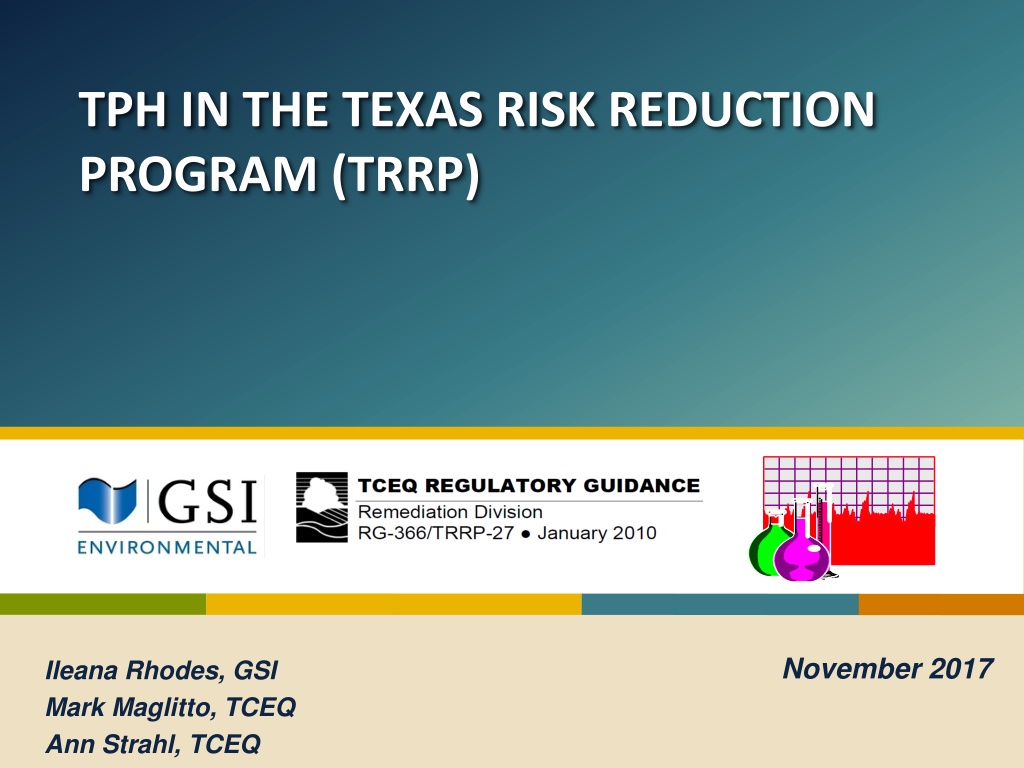
 undefined
undefined














